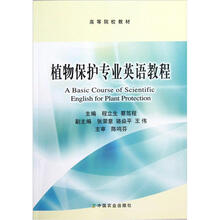前言
Unit 1 (A) The Concept of Disease m Plants
Unit 1 (B) Molecular Plant Pathology
Unit 2 (A) Genes and Disease
Unit 2 (B) The Gene-for-Gene Concept
Unit 3 (A) Systemic Acquired Resistance
Unit 3 (B) Defe e Through RNA Silencing by Pathogen-derived Genes
Unit 4 (A) Integrated Control of Plant Diseases
Unit 4 (B) New Tools in Epidemiology
Unit 5 (A) Characteristics of Plant Pathogenic Fungi
Unit 5 (B) Isolating the Pathogen
Unit 6 (A) Characteristics of Plant Pathogenic Bacteria
Unit 6 (B) Phytoplasmas and Spiroplasmas
Unit 7 (A) Detection and Identification of Plant Viruses
Unit 7 (B) Virus Infection and Virus Synthesis
Unit 8 (A) Characteristics of Plant Pathogenic Nematodes
Unit 8 (B) Root-knot Nematodes.Meloidogyne spp.~
Unit 9 (A) I ect Biodive ity and Co ervation
Unit 9 (B) Reaso for the Studying of I ects
Unit 10 (A) External Structure of I ects
Unit 10 (B) Integument and Internal Systems of I ects
Unit 11 (A) Embryonic and Postembryonic Development of I ects
Unit 11 (B) Specialization of I ects
Unit 12 (A) Behavior and Habits of I ects (1)
Unit 12 (B) Behavior and Habits of I ects (2)
Unit 13 (A) Environment Facto Affecting Development of I ects
Unit 13 (B) Environment and I ects
Unit 14 (A) I ect Systematics.Phylogeny and Classification
Unit 14 (B) Naming,Describing and Classification of I ects
Unit 15 (A) Detrimental I ects
Unit 15 (B) Beneficial I ects
Unit 16 (A) Integrated Pest Management
Unit 16 (B) Reaso for I ects Becoming Pests and Assesment of Pest Status
Unit 17 (A) What Is a Pesticide?
Unit 17 (B) Generic Terms,Trade Names,and Chemical Names
Unit 18 (A) Agriculture Formulatio
Unit 18 (B) The Formulatio of Pesticides
Unit 19 (A) Chemical Control in USA
Unit 19 (B) I ecticides
Unit 20 (A) Herbicides
Unit 20 (B) Mode of Action
Glossary
English-Chinese Common Names of Pesticides
Key to Exercises
References

 缺书网
缺书网 扫码进群
扫码进群





